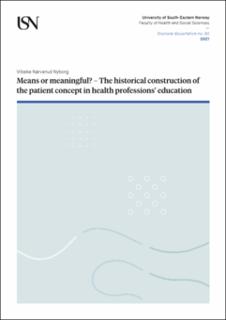| dc.contributor.author | Narverud Nyborg, Vibeke | |
| dc.date.accessioned | 2021-04-07T09:25:01Z | |
| dc.date.available | 2021-04-07T09:25:01Z | |
| dc.date.issued | 2021 | |
| dc.identifier.uri | https://hdl.handle.net/11250/2736556 | |
| dc.description.abstract | All concepts have an origin. They shape, and are shaped by the context in which they exist. This thesis explores how the construction of the patient concept has been given meaning, changed and developed in the context of education of both doctors and nurses during the period 1880 – 1940. The overall aim was to gain insights into the historical construction of the concept of the patient as part of the education of health professionals, and to use historical knowledge to create an awareness of how the conceptual understanding of the patient has been shaped by reality. Moreover, I intend to gain an understanding of how these conceptual constructions of the patient have contributed to shaping the nature of education provision, through an analysis of the language used.
Two research questions shaped this inquiry: 1) during a period of modernization, what view of the patient is presented in nursing and medical education? 2) In what ways can historical knowledge of the patient as revealed in historical medical and nursing education inform our future healthcare education and practices?
The thesis has a historical methodological approach based on source scrutiny and hermeneutics. The analysis are based on written sources, mainly from a Norwegian context related to the education of nurses and doctors. Use of language as linguistic representations in meaning making in the construction of concepts, constitute significant theoretical perspectives for the historical analysis. The professionalization of the two professions and modernization processes in society as part of 19th and 20th century developments play important roles in this context. In addition, when placing historical knowledge into present use, theory of person-centredness will contribute to frame the discussion and analysis in the thesis.
I argue that the construction of the patient within the two professions was built on different understandings of reality and what constituted knowledge for them as part of the modernization processes that had impact on the education. I further claim that the patient through history has been strongly connected to diseases and society’s changing response to this as knowledge and education developed. This includes an acknowledgement of the need to include social and cultural understandings in medical and health perspectives.
My findings direct us to draw historical attention to the patient as a fulcrum in medical and nursing education, emphasising the impact and power of education in the construction of patients in the professional understanding of historical reality. In this respect the patient is constructed as a phenomenon in the intersection between bio-medical, social and cultural perspectives, and is strongly connected to the tasks and objectives carried out by the different professions, and in accordance with the challenges they faced during the modernization of society.
Bringing attention to historical and linguistic awareness of the patient as a significant concept in the field of medicine and health is useful in addressing future challenges in both education and practice for healthcare professions. I argue that any person becoming a patient is in danger of losing the power to define themselves and instead can become means in a context beyond themselves. This situation amplifies the potential dehumanizing factors in medicine and health in relation to the patient both as a concept but also in treatment. The solution to this can best be achieved by emphasizing more humanizing aspects in education and in practice in the call for a renewed focus on a holistic approach to the patient. This calls for a re-emphasis on holism in future education policy in all health care professions, as well as awareness in education programs about how they include the patient as a concept and as a person in curricula and litterature. | en_US |
| dc.language.iso | eng | en_US |
| dc.publisher | University of South-Eastern Norway | en_US |
| dc.relation.ispartofseries | Doctoral dissertations at the University of South-Eastern Norway;90 | |
| dc.rights | Navngivelse-Ikkekommersiell-DelPåSammeVilkår 4.0 Internasjonal | * |
| dc.rights.uri | http://creativecommons.org/licenses/by-nc-sa/4.0/deed.no | * |
| dc.subject | person-centred healthcare | en_US |
| dc.subject | history of medicine | en_US |
| dc.subject | history of nursing | en_US |
| dc.title | Means or meaningful? – The historical construction of the patient concept in health professions’ education | en_US |
| dc.type | Doctoral thesis | en_US |
| dc.description.version | publishedVersion | en_US |
| dc.rights.holder | © The Author, except otherwise stated | en_US |
| dc.subject.nsi | VDP::Medisinske Fag: 700::Helsefag: 800::Medisinsk/odontologisk etikk, atferdsfag, historie: 805 | en_US |
| dc.source.pagenumber | 250 | en_US |

